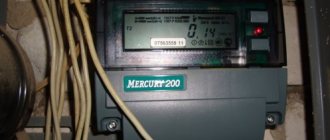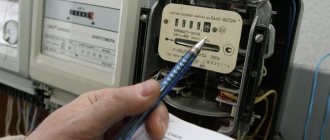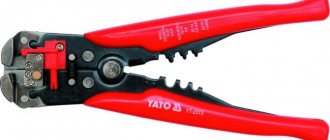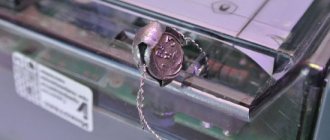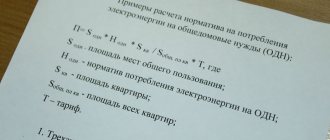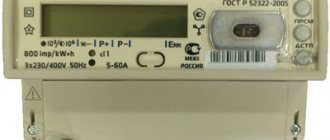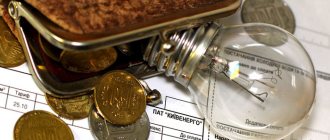It is necessary to transmit the data of an individual meter within a certain period of time. This ensures payment is calculated according to current tariffs. But in order to avoid discrepancies and errors, you need to correctly take the electricity meter readings. In fact, there is nothing complicated here, although not everyone knows where to look and which button to press to rewrite the necessary information.
How to take readings
Depending on the model of the electricity meter, different methods for obtaining information are used.
Old meters
Mechanical induction devices have been popular for quite some time. At the moment, they are gradually giving way to electronic IPUs, which provide better control of electricity consumption. Although the demand for classic meters is gradually decreasing, they are still found in private houses and apartments.
The device is single-tariff (single-phase), so there is no need to perform complex calculations to take readings. It is recommended to select a conditional day of each month for writing off data from the electric meter, preceding or included in the period for submitting information.
The procedure is quite simple:
- A standard mechanical apparatus has a dial with 5–7 digits, and as it works, the numbers change from 0 to 9. After one department has completed a full revolution, the next one begins. The dial is divided into two halves: the left one shows how many kW/h have been consumed since connection, the second (red) is separated by a comma and indicates tenths (hundredths) of a kilowatt.
- It is necessary to write off the main part of the characters 000024.8 (seven-digit order). The basis is 000024 kW/hour.
- Depending on the requirements of the management company or resource supplying organization, the information received must be submitted without changes or the difference between the current and previous values must be independently calculated. So, if over the past month the readings were 000003, then: 000024–000003=21 kW/h.
In both old and new mechanical electricity meters, the numbers that are not taken into account in the calculations are clearly highlighted at the end of the number row
The process may be difficult due to the counter resetting to zero after reaching the maximum value. In such a situation, you must first write down the old data. For example, for May (conditionally) it was 999969 (without a decimal point), the new information is 000003 (1 is substituted at the beginning, the result is 1,000003).
1 000003–999969=34 kW/h (current readings).
It is necessary to understand that any illegal attempts to change information about electricity consumption will lead to serious trouble.
On a note! There are mechanisms in which there is no division into main and auxiliary numbers. In such a situation, you need to read and enter all available numbers into the receipt.
New counters
Modern single- and three-phase metering devices differ significantly from mechanical ones. The main difference is that IPUs are equipped with an electronic dial and can be multi-tariff, which provides significant savings in energy consumption. To correctly determine the readings, you need to understand the available devices.
The following varieties are distinguished:
- single tariff, the readings of which are not divided into zones;
- two-tariff – T1/T2;
- three-tariff – T1/T2/T3.
Data is collected from such devices as follows:
- You need to press a button on the mechanism body. It can be called differently, depending on the IPU model, most often - “PRSM”, “Input” or “Frame”.
- After pressing, the required values sequentially appear, which have the corresponding signatures - T1, T2 or T3.
- The main current indicators of 5–6 digits to the decimal point are written off one by one, depending on the type of counter.
- On an electronic display, the characters are separated by a noticeable comma, and in some IPUs the hundredths and tenths are significantly smaller.
- The information is transmitted directly to the management company or supplying organization or calculated independently.
In electric meters with an electronic display, after pressing the control key, the data is displayed on the screen: the number of kilowatt-hours consumed and the tariff number (indicated in the upper left corner)
Explanation of symbols for various electronic devices:
- Single tariff. Reflect the total resource consumption without division.
- Two-tariff. T1 – day zone (from 7 am to 11 pm), T2 – night period (from 23.00 to 7.00).
- Three-tariff. T1 – peak zone, which has two time periods: from 7.00 to 10.00 and 17.00 to 21.00; T2 – night (from 23.00 to 7.00); T3 – half-peak zone (from 10.00 to 17.00 and from 21.00 to 23.00). Time periods may vary by region.
The multi-tariff IPU must be correctly connected and pre-configured so that it records readings exactly for the allotted period. In some situations, this may require agreement with the utility provider.
Before purchasing and connecting multi-tariff meters, you should consult your energy supply company about the possibility of using them in your region
How is energy measured?
Translated from Greek, energy means activity, force, action. It is a scalar quantity and measures all kinds of motion and interconnections of matter. Energy is denoted by the letter E. The units of measurement for this quantity are: in the SI system - joule (J), in the GHS system - erg.
Electrical energy consumed by electrical appliances is calculated by meters. They provide numerical readings of power consumption (kW) per kWh.
The Relationship Between Strength and Energy
A connection has been established between the conservative force, which causes the potential energy of all interacting bodies, and this energy.
For your information. Conservative forces are those forces that do work to move a point. In this case, the work is determined by the extreme positions of this point: initial and final.
Conservative forces include the following forces:
- heaviness;
- elasticity;
- Coulomb forces.
If you close the trajectory of a point under the action of conservative forces, it will be equal to zero.
You can trace the connection using the following algorithm:
- When at any point in space a body is subject to the action of a conservative force, it means that it is located in a potential field.
- A change in the position of a body within a field causes a change in potential energy, in which a conservative force does work.
This work can be expressed mathematically. For example, the body moved in a random direction r, deviating from the initial position by a very small distance dr. This means that dA = F*dr*cosα = Fr, dr, where F = F* cosα is the projection of the force onto the direction r.
There is an equality: dA = – dEп, where Ep is potential energy. So, putting an equal sign between the two expressions, it turns out:
Fr *dr = – dEп, from which Fr = – dEп/dr is expressed.
The ratio dEп/dr is a quantity showing the rate of change of potential energy along a given direction; it is the derivative of Ep in the r direction.
Attention! The minus sign means a decrease in potential energy in the direction dr. The partial derivative symbol indicates that the differentiation of the potential energy Ep (x, y, z) occurs only with the argument x, with the other two unchanged.
Power and energy
Power P is the work done per unit of time. The unit of power is watt (W). To find out how many watts are 1 kW, you need to remember that “kilo” is 103. Therefore, 1 kW = 103 W, and 10 kW = 104 W.
Typically, the power of electrical receivers is measured in kilowatts. Applicable to technology, there is also a measurement of power in horsepower (hp). One such horsepower is equal to 736 watts.
Power and horsepower
The ability of a certain body or an entire system to perform work is characterized by its energy. Energy unites in its concept all events in nature. Different types of movement are characterized by different types of energy.
Advice. Mechanical energy related to the movement of a body is called kinetic, associated with the mutual position of bodies (body parts) of the system - potential.
Calories and joules
Before you figure out how to convert (convert) calories to joules and vice versa, you need to know what these two concepts mean.
The joule is a unit used to measure work, energy, or heat. In the international SI system, the joule is denoted by J (J). The work done by a force of one newton (1N) to move a point in the direction of application of the force one meter (1m) is equal to one joule (1 J).
Calorie is a quantity not separately reflected in measurement systems, used to determine the amount of heat. To heat 1 g of water by 1 C0, you need to spend energy equal to 1 calorie (cal). In this case, 1 cal = 4.1868 J.
Communication with other units
You can use an online calculator to express calories in joules and back.
The program interface allows you to enter the values of the required quantities (using abbreviations of multiple values). When you don’t have the Internet at hand, it’s easy to make a translation by making a proportion. For example, you need to find out how many kilocalories are in 100 kJ. To do this, make up the proportion:
- 1 kcal = 4.1868 kJ;
- X = 100 kJ.
Solving the proportion, we get the expression X = 100 * 1/4.1868 = 23.9 kCal. The answer is that 100 kJ contains 23.9 kcal.
How to calculate electricity using a meter
To eliminate errors, it is necessary to carry out the calculation correctly.
Where to find tariff information
To independently determine the amount of electricity payment for the current period, you need to know exactly the cost of the service. Depending on the region of the Russian Federation, as well as additional parameters (type of settlement, availability of certain electrical appliances and rates at different times of the day), the tariff for the population may differ significantly.
You can find out the cost for a specific territory as follows:
- Check on the website or at the office of the utility service provider. The data must be indicated on stands in specialized payment centers.
- When tariffs increase, information is published in the official press and on the website of the regional commission that deals with this issue. The department’s website also has an online calculator that roughly calculates the fee for a specified time period.
- Look on the receipt. During the period when tariffs increase, some discrepancies are possible.
Attention! It is not recommended to use unofficial sources of information, as they may contain unverified or outdated information.
Calculation
It is not difficult to calculate the payment for consumed electricity; to do this, you need to follow a certain scheme, depending on the type of device.
Single tariff electricity meter
Conventionally, the current readings are 000354, for the last month – 000296.
The tariff for Moscow residents who live in gasified houses that do not fall under the territory equated to rural areas for the second half of 2022 is 5.38 rubles. per kW/h.
Based on the available values, the calculation of the expense and payment amount for the current month will be as follows:
354–296=58 kW/h x 5.38 rub. = 312.04 rub.
Two-tariff IPU
Electric meter readings for the new billing period: T1 – 000898, T2 – 000576. Previous values: T1 – 000840, T2 – 000539.
The tariff for the peak zone in Moscow (in houses with gas stoves) is 6.19 rubles, for the night period - 1.92 rubles.
You need to determine consumption and payment in stages; first you need to calculate current consumption:
T1. 898–840=58 kW/h x 6.19=359.02 rub.
T2. 576–539=37 kW/h x 1.92=71.04 rub.
Total for the month: 359.02+71.04=430.06 rub.
Three-tariff electricity meter
It is necessary to take readings from three zones: T1 – 000587, T2 – 000456, T3 – 000832. Data for the past month: T1 – 000545, T2 – 000415, T3 – 000780.
Tariffs by time: peak zone – 6.46 rubles; night – 1.92 rubles; half peak – 5.38 rub.
To find out how much you need to pay per month, you need to count your expenses sequentially.
T1: 587–545=32 kW/h x 6.46=206.72 rub.
T2: 456–415 = 41 kW/h x 1.92 = 78.72 rub.
T3: 832–780 = 53 kW/h x 5.38 = 285.14 rub.
Next you need to add up all the data:
206.72+78.72+285.14=570.58 rub.
This is the amount you need to pay for light.
It is taken into account that the final figures in the receipt may differ slightly: you need to pay attention to the “ONE” line, which reflects the general readings for the house and is included in the payment.
Meanings of numbers and their decoding
There are eight digits on the counter dial, 5 of which are black and 3 are red. Red ones indicate the number of liters used. They should not be considered, since payment for consumed water is made in cubic meters. That is, we are only interested in black numbers indicating the number of cubic meters of water we used during the reporting period.
Next you need to proceed as follows:
- Write down the required numbers in a notepad or notebook in the order in which they are shown on the device.
- Round the last figure up if the number of liters is more than 500.
- Multiply the resulting value by the established tariff for water payment and enter the resulting value into the paybook. Now you can go to the nearest bank branch to pay for consumed water.
Please note: Before taking readings from the water meter, make sure that the pipes in the house do not leak, and that the taps in the bathroom and kitchen provide shut-off water at normal levels. If all sources of water consumption in the house are turned off, and the meter continues to “increase the numbers”, even at a minimum speed, it means that there is a leak in the home network that needs to be identified and eliminated to prevent paying for unused water
If all sources of water consumption in the house are turned off, and the meter continues to “increase the numbers”, even at a minimum speed, then there is a leak in the home network that needs to be identified and eliminated in order to prevent paying for unused water.
You can check the correct operation of hot and cold water meters as follows:
After turning off all the taps in the house, pay attention to the meters. They must be in a stationary position, and their readings must remain unchanged
After this, you need to take a 10 liter pan and fill it with water to the brim. This manipulation should be performed five times, thus gaining 50 liters. Then check the readings again with the actual water calculation. They should increase by exactly 50 liters. If there are discrepancies between the actual and nominal readings, the meters should be checked by the appropriate organization for possible problems and malfunctions.
Retrieving information and calculations for different models
Although the operating principle of modern IPUs is almost identical, depending on the variety there may be some differences:
- "Mercury 200". The “Enter” button is pressed, after which the time, date, readings by zone and total flow appear. The letter designation of the tariff is in the upper left corner. According to the described calculation example for a specific territory, the total payment amount is calculated.
- "Energymera". The most common are two- and multi-tariff modifications. Readings from this meter are taken according to a scheme similar to the previous option. The main difference is that you need to press the "PRSM" button.
- "Micron". It is not difficult to take readings from such a meter, provided that certain nuances are observed. At the bottom left side of the case there is a button, when pressed, the necessary information is displayed. A special feature of the device is that the designations of tariff zones T1, T2 or T3 do not appear; they are already signed at the bottom of the screen and highlighted with a tick. The payment amount is calculated according to the standard scheme.
- Saivan. The most economical option that is popular. It differs from others in the absence of a button that highlights specific values and shows data sequentially with a small interval. The necessary parameters are recorded and checked, for which it is necessary to let the counter go around in a circle. The calculation depends on the modification of the electricity meter and the current tariff.
Advice! To eliminate errors when taking readings, you must first familiarize yourself with the product data sheet, which contains the correct algorithm of actions.
When choosing an electric meter, it is advisable to give preference to domestic models or meters manufactured in the CIS, since imported options may not be adapted to our networks
Where is the electricity meter located?
There is one very strict rule that determines the availability of the meter for taking electricity readings. That is, the controller from the energy supplying organization must freely approach the meter at any time and read the electric current consumption data from it. Therefore, in apartment buildings, devices are installed in electrical distribution panels, which are located on staircases.
In some old houses, such a distribution board is not provided at the entrance. Therefore, electricity meters were installed in apartments. This is a big problem today, because not all owners of such apartments open their doors to inspectors.
Counter in a cabinet on a pole
As for private houses, there are two places that can be used to install the metering device: on the facade of the house or on a pole, from the latter wires are stretched to the house. Other installation options are prohibited.
Where to submit readings
It is necessary to take data from the electricity meter within a specified period, which precedes or includes the period allotted for sending information; the exact interval is specified in the contract.
Testimony from the public is received by the utility service provider. This role may be played by a supplying organization, a management company or a homeowners' association. It is taken into account that these powers can be delegated to special settlement organizations or auxiliary institutions.
You can transmit electricity meter readings using different methods:
- Enter the information on the receipt and bring it to the billing department.
- Send via Internet. To do this, you need to fill out the appropriate table on the organization’s website or in your personal account.
- Indicate on the form that you want to put it in a special box installed in various institutions.
There are also other modern methods that involve the use of technical devices.
Payment Methods
Today, the population is provided with several main options for paying for consumed electricity:
- Bank branches and self-service devices. You need to transfer money using a payment document or through a special section of the terminal.
- Personal account, payment services, mobile applications. To do this you will need access to the Internet.
- Post offices or payment centers.
- Directly to the utility service provider through branch cash desks.
Regardless of the chosen method, you must receive confirmation of the completed payment.

